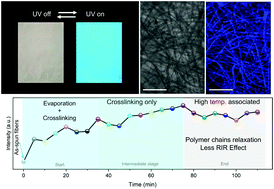A curing process in nanofiber-based thermosetting polymers involves both rapid solvent evaporation and chemical cross-linking at the nanoscale, which altogether present a complicated scenario to study. In this paper, we employed aggregation-induced emission (AIE) phenomena with the help of fluorescence tests and scanning electron microscopy to study functional fluorescent AIE-based thermosetting nanofibers with reference to their fabrication, properties and possible applications. The properties that dictate the electrospinning of nanofibers were first studied together with their properties. Finally, we tested the obtained functional nanofibers as thermo-sensitive probes and chemosensors. These applications were possible courtesy of the restriction of intermolecular rotation (RIR) mechanism of the AIE luminogen (AIEgen) of TPE, which was successfully knitted onto the thermosetting polymer Epoxy. Its presence around the TPE-Epoxy structure dictates the fluorescence behaviors of the final composite depending on the material environment.
